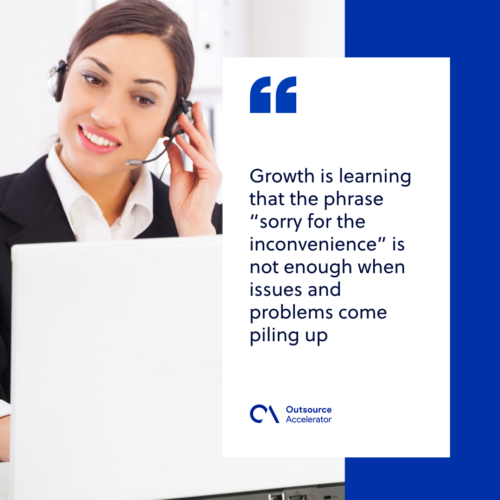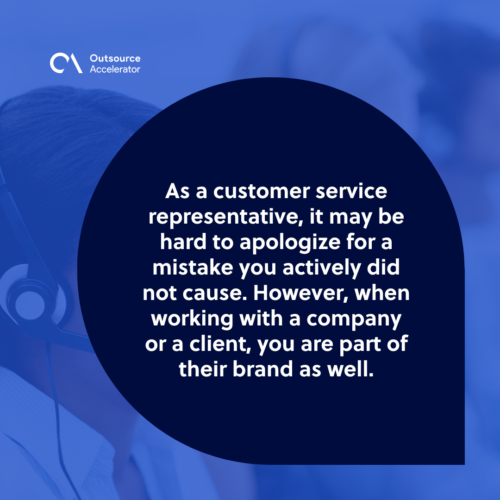Improving customer service, one sincere apology at a time

Improving processes, workflows, and performance is critical to running a successful business in any industry. This is especially true for a customer support team whose main task is to handle customer relationships.
As tedious and time-consuming as it sounds, improving customer service is a great place to start. A company’s customer service team is the first contact when dealing with consumers and the general market.
Continuous development and learning are vital to improving their services, one department at a time. Why? The aim should be to build a positive brand reputation and boost customer satisfaction through excellent customer service.
Growth is learning that the phrase “sorry for the inconvenience” is not enough when issues and problems come piling up. It’s also about considering the customer’s feelings and being able to stand in the customer’s shoes.
We encourage everyone, from rank-and-file employees to the management team, to do better each day.

“Sorry for the inconvenience” and other apologetic phrases
In today’s world, where most interactions happen online or through the phone, miscommunication is inevitable.
Any attempts to sound sincere or sincerely apologize might appear condescending or mocking. And this all gets in the way of providing excellent customer service.
But that’s not always the case.
Most people can express themselves fully through written communication, such as emails and live chatting. Some might prefer verbal communication.
What’s important is that the line of communication between the two parties is clear.
Properly apologizing can ease the tension right off the bat, especially when dealing with upset customers with issues and problems.
Here are apologetic phrases that will come in handy when handling situations.
“Thanks for letting us know about the issue.”
This phrase implies the customer is determined and proactive. Positive words like this help ease the situation and appease the customer.
“We understand how frustrating this is.”
Empathizing with the customer is a top priority when interacting with them. Even outside of the workplace, empathy makes the world go around.
“Please accept our deepest apologies.”
When it comes to apologies, backing it up with a perceivable action is the best way to go. Saying ‘sorry’ and not following up on it may lead customers to think that the company wasn’t sincere at all.
Using the royal “we”
The use of the royal “we” started way back with the monarchs. The history of this regal pronoun trickled down to vernacular speakers to show collectivism while speaking alone.
“I’m sorry” versus “We’re sorry”
Using ‘we’ in this context implies that the company and the brand are liable for any nuisances and issues caused by the product or service. Of course, customer service reps still have to account for the delay caused by the problem.
The best way to show the company cares is by resolving the issue once and for all.
Dos and don’ts of apologizing in and out of the office
We may think that we know the basics of apologizing until we catch ourselves in a situation where every “I’m sorry!” sounds worse than the other.
As a refresher, here are some dos and don’ts of apologizing.
Do own up to your mistakes
Time and time again, owning up to your mistakes will always be the best course of action.
As a customer service representative, it may be hard to apologize for a mistake you actively did not cause. However, when working with a company or a client, you are part of their brand as well.

mpact of your wrong judgment.
When customers complain about a persistent problem with the product or the service, keep in mind the delays it might cause.
Trying to defend yourself or the brand may cause further frustration for both of the parties involved.
Tip: When brands apologize, they usually have a quick rundown of what happened and the steps they’re taking to minimize the issue’s impact.
Don’t minimize the situation
Trivializing a customer’s concern can make them angry and, therefore, harder to talk to.
“I’m sure our other customers don’t have the same problem.” Don’t call customers out this way. They won’t like it.
It minimizes and invalidates the customer’s feelings about the issue. Instead, try to focus on the solution to alleviate customer frustration.
You can ask further questions about their issue and provide further assistance. Expressing empathy can also make all the difference.
Training customer service representatives to sound more empathetic over the phone
When training customer service representatives, instill the skills of active listening, being empathetic, and being proactive. Even over the phone, through email, or chat, sounding sincere and helpful will go a long way.
Having empathetic employees will affect the growth and development of the company from within. Customer service, as a job, requires these skills to flourish in the workplace.
In a company, boosting empathy should come easy, especially when there’s open communication within the team.
Why soft skills are important in the workplace
Would you think businesses and organizations will grow if everyone doesn’t know how to communicate well? Having someone to show in the workplace won’t mean a thing if you can’t say messages clearly and mean them.
It’s just as important as hard and technical skills. Soft skills make workplaces work.







 Independent
Independent




